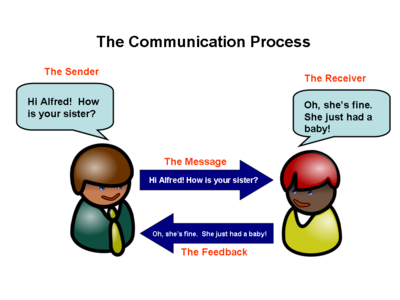Life Skills Development/Module Three/Process
Topic 1:
Contents
Process of Communication
Introduction
Communication involves a process of sending and receiving of messages. The breakdown in this process negatively affects quality of life. The elements of communication involves the origin of thoughts or emotions; the transfer of feelings, thoughts or actions; a message; the way in which the message is sent and the understanding of the feelings, thoughts or actions within the message received.
Content
Concepts of Communication
Communication is a complex process of creating and sharing meaning that involves at least two persons with a common understanding of the message. It involves the processing of information which is dependent on understanding as determined by expectations. The objectives of the process must be relevant to the purpose for which it is intended. Prior experiences will determine how the information is understood and individual differences determined by values, interests, life goals and intelligence levels will impact the process.
There are four main skills in the communication process:
1. Listening - an active process involving selecting, attending to, creating meaning from, remembering and responding to verbal and non-verbal messages.
There are four levels of listening:
a) Non-listening - making no effort to listen b) Marginal listening - is easily distracted c) Evaluative listening - focuses on content but disregards the speakers feeling d) Active listening - pays close attention and gives verbal and non-verbal feedback.
2.Questioning - check facts, gain further information and build rapport to explore opinions or attitudes.
3.Clarifying - the process of simplifying, explaining, spelling out, shedding light on or making clear the message received.
4.Responding - an appropriate reaction to the message received.
Communication can help you recognize and realize your potential. Hence great importance has been placed on the process and its use.
Why then is the process of communication so important?
The process of communication is important as human beings need to make sense of their environment and share that sense with others by creating meaning through the use of verbal and non-verbal messages. Communication touches every aspect of our lives. It is vital for our wellbeing and is necessary to develop quality interpersonal and intrapersonal relationships. Learning how to understand and improve communication will improve relationships with family, friends, colleagues and loved ones that will ultimately enhance physical and emotional health and well being.
Viewing Communication channel
The image below gives the channel in communication process
The image illustrates the following:
- Sender - person who is sending the message to another person
- Reciever - person who recieves the message from the sender
- Encodes - is a technique by which the senders uses to send the message into languagr, symbols or signals
- message - is the idea or information that the senderwants to pass on to the reciever
- Channel- is the means by which the message is sent through either verbal or non-verbal
- Decode - is when the reciever interprates and translate the senders message
- responding- can be actions or the way in which the sender oe reciever acts to the message
- feedback - is the reciever's reaction to the message recieved, this may be verbal or non verbal
Objectives/Outcomes:
Learners should be able to:
- explain the communication process
- process information received through communication
- develop strategies to improve their communication
Activities & Assignments:
- Game - Passing the Message
Standing in a circle, one learner decides on a short message and shares it in a whisper with the person standing next to him/her. This process continues until the message comes back to the learner on his/her other side who will share the message with the entire group. The learner will then recite the original message sent. Participants will share the different messages they heard as it was passed around the circle.
- Listen, Pair and share
Learners will listen to music/poem/song. In pairs they will discuss the messages heard and report on their understanding and feeling about the message and how it affects them individually.
Summary:
Communication is interactive. The understanding of the message depends on how ideas and feelings shared within a context.
Assessment:
How will I assess my progress
You may use Self and Peer assessment to evaluate your progress.
1. Discuss with another learner the process of communication as you have experienced through interacting with this lesson and how it has impacted you. Identify the process that is least effective and identify strategies that can be employed to improve this. Identify your strength and discuss why you have been so successful using that process.
Self assessment
Questions for Reflection
Can I identify the varying methods of communication?
What are the methods I am comfortable using whilst communicating?
How do I deal with those methods that are necessary but I am not compfortable using?
How does variables such as the environemnt, prevailing situation or language affect the method I choose to use in the communication process?
What do you expect of others in this process?
Peer assessment
Presentations, discussions and dramatizations
Use role play to familiarize your peers with your understanding and experiences in the communication process.
Discuss with your peers how they feel about how you communicate with them.
Present scenarios of your experiences and share your approach to problem solving.
Support Materials
- Handouts
- Videos
- Skits
- Power point presentation
- Comics
- Animations
